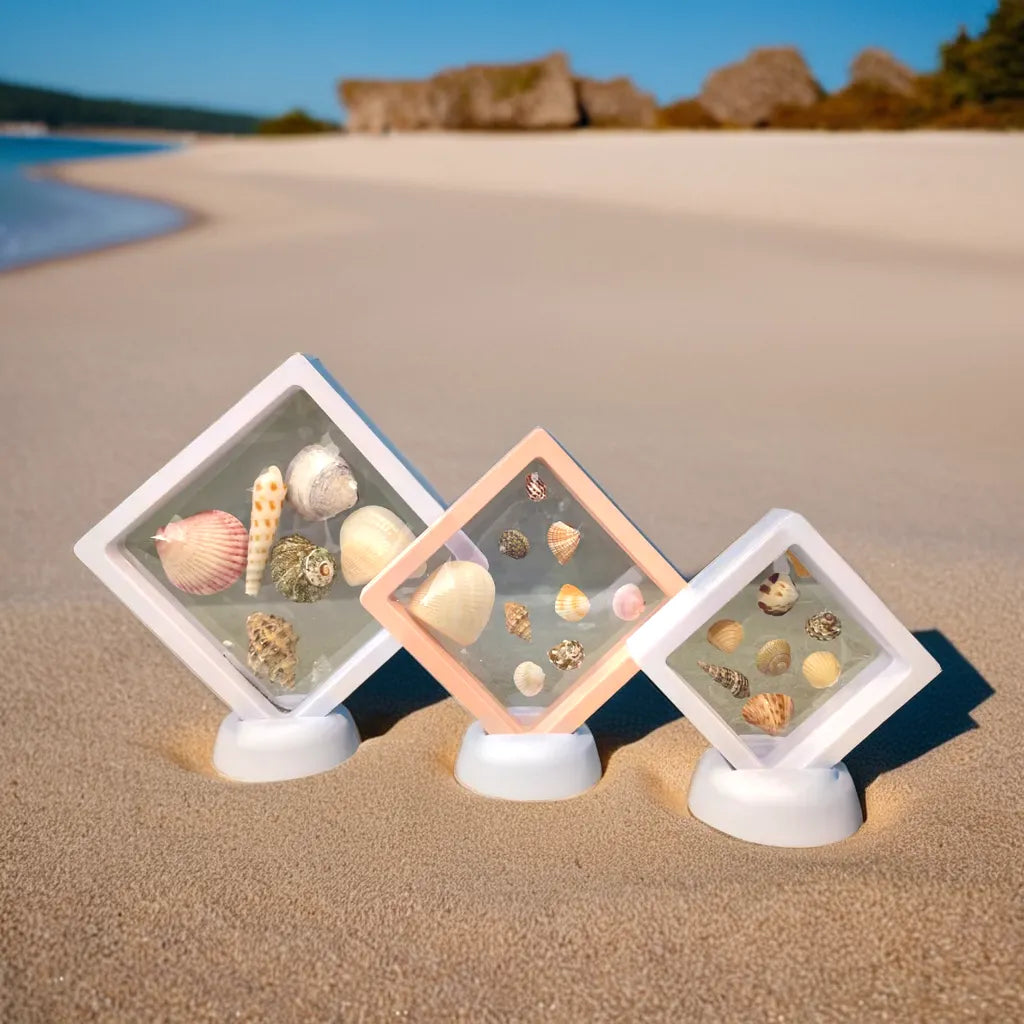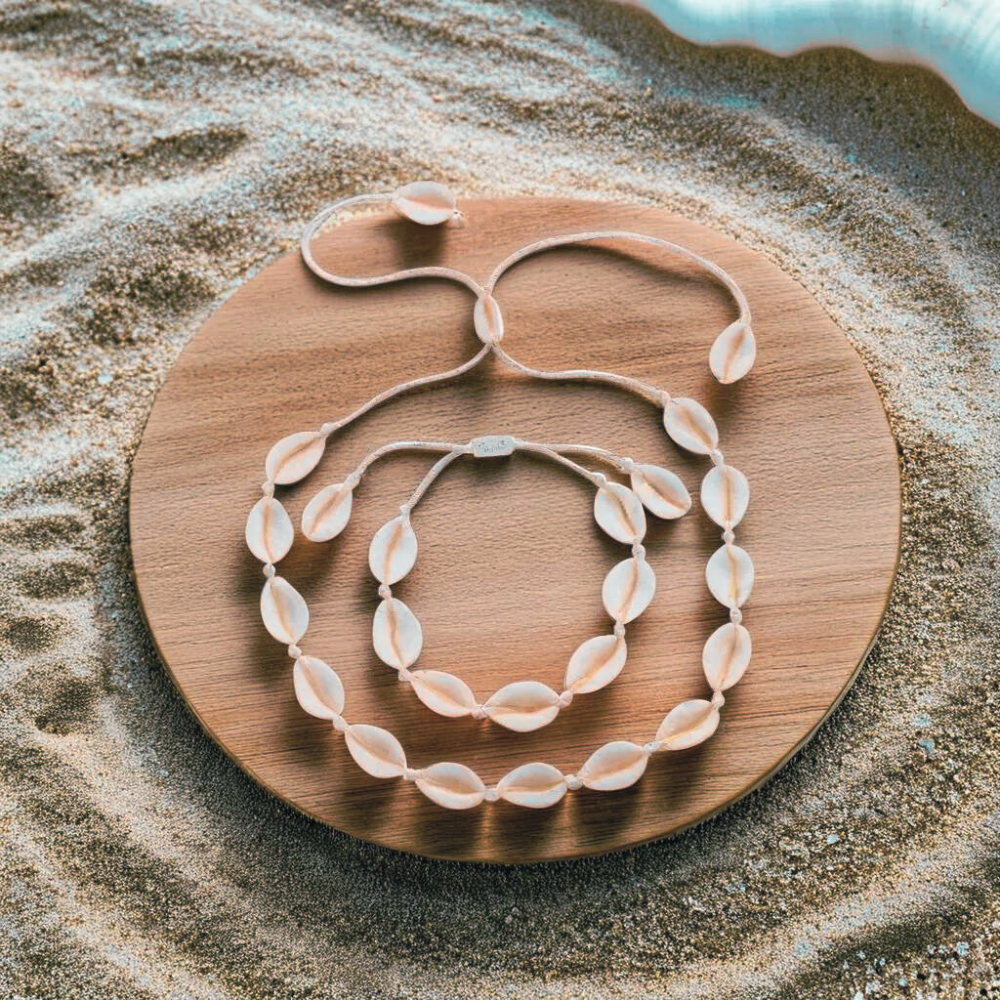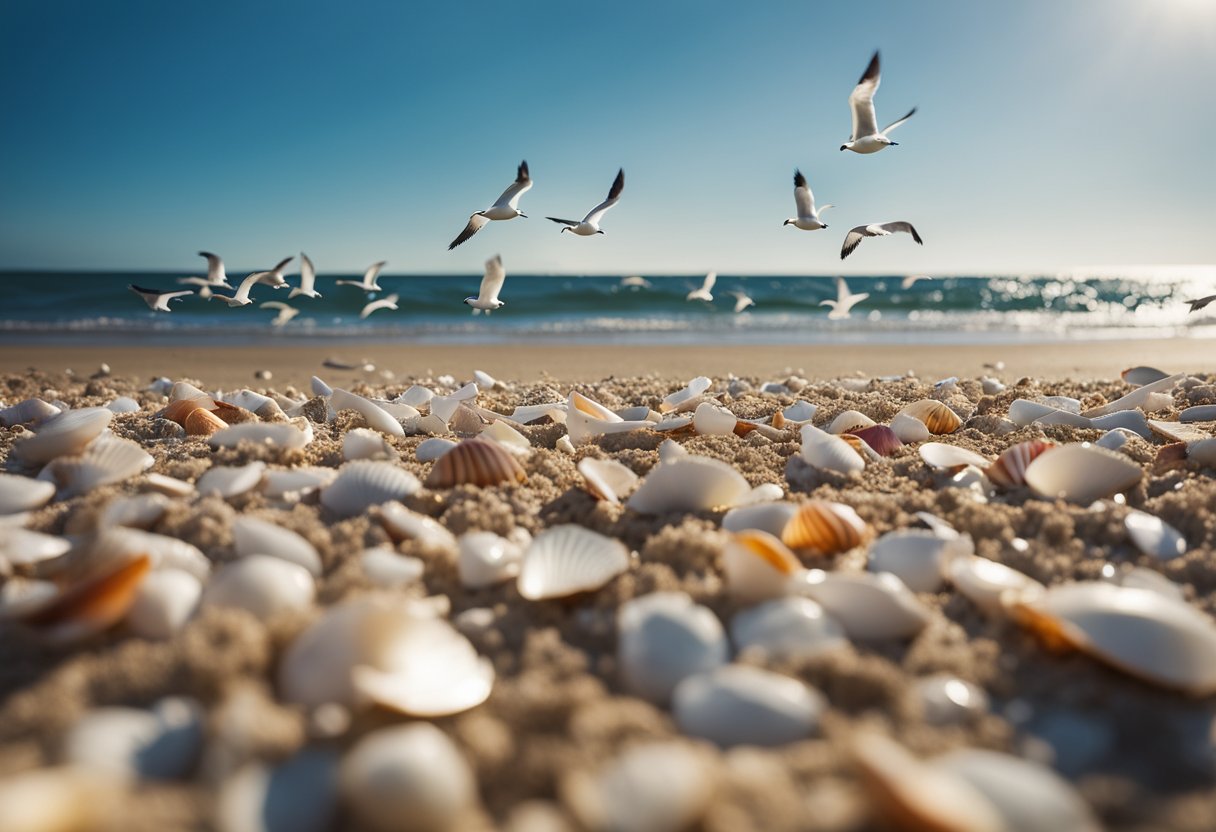Walking along the Florida coast, beachgoers can find an array of beautiful and unique seashells. Common varieties include the Florida Spiny Jewelbox, Arcinella cornuta, which features thick, heavy shells with rows of pleated ribs and a pink or red interior. These fascinating bivalve shells are often found near coral reefs, making them a favorite find for many shell collectors.
 Another popular type is the Cockle shell, typically found in shades of white, brown, red, and yellow. Cockle shells are often the bivalve homes of marine mollusks and can be discovered in various sizes on Florida's beaches. Their round and often ribbed appearance makes them easy to identify and a delightful addition to any collection.
Beachcombers will also commonly come across Ark shells, known for their varied colors and abundance along the East coast of Florida. These clam-like seashells are frequently found in large quantities, providing ample opportunity for discovery and collection. By understanding the types of seashells present on Florida beaches, enthusiasts can more easily identify and appreciate the diverse marine life that inhabits these coastal areas.
Another popular type is the Cockle shell, typically found in shades of white, brown, red, and yellow. Cockle shells are often the bivalve homes of marine mollusks and can be discovered in various sizes on Florida's beaches. Their round and often ribbed appearance makes them easy to identify and a delightful addition to any collection.
Beachcombers will also commonly come across Ark shells, known for their varied colors and abundance along the East coast of Florida. These clam-like seashells are frequently found in large quantities, providing ample opportunity for discovery and collection. By understanding the types of seashells present on Florida beaches, enthusiasts can more easily identify and appreciate the diverse marine life that inhabits these coastal areas.
 Seashells on the Florida coast vary greatly in their taxonomy, sizes, and color variations. This diversity makes shell collecting both fascinating and complex.
Seashells on the Florida coast vary greatly in their taxonomy, sizes, and color variations. This diversity makes shell collecting both fascinating and complex.
 Seashells along the Florida coast come from various habitats, each with unique environmental conditions that influence the shells' characteristics. These habitats include coral reefs, sandy shores, mangroves, and grass flats.
Seashells along the Florida coast come from various habitats, each with unique environmental conditions that influence the shells' characteristics. These habitats include coral reefs, sandy shores, mangroves, and grass flats.
 Seashells found on the Florida coast play critical roles in the environment. They help control beach erosion, indicate environmental health, and create habitats for other marine life.
Seashells found on the Florida coast play critical roles in the environment. They help control beach erosion, indicate environmental health, and create habitats for other marine life.
 This section provides answers to common questions about seashells found on the Florida coast, including types of shells, how to identify them, and legal considerations for collecting.
This section provides answers to common questions about seashells found on the Florida coast, including types of shells, how to identify them, and legal considerations for collecting.
 Another popular type is the Cockle shell, typically found in shades of white, brown, red, and yellow. Cockle shells are often the bivalve homes of marine mollusks and can be discovered in various sizes on Florida's beaches. Their round and often ribbed appearance makes them easy to identify and a delightful addition to any collection.
Beachcombers will also commonly come across Ark shells, known for their varied colors and abundance along the East coast of Florida. These clam-like seashells are frequently found in large quantities, providing ample opportunity for discovery and collection. By understanding the types of seashells present on Florida beaches, enthusiasts can more easily identify and appreciate the diverse marine life that inhabits these coastal areas.
Another popular type is the Cockle shell, typically found in shades of white, brown, red, and yellow. Cockle shells are often the bivalve homes of marine mollusks and can be discovered in various sizes on Florida's beaches. Their round and often ribbed appearance makes them easy to identify and a delightful addition to any collection.
Beachcombers will also commonly come across Ark shells, known for their varied colors and abundance along the East coast of Florida. These clam-like seashells are frequently found in large quantities, providing ample opportunity for discovery and collection. By understanding the types of seashells present on Florida beaches, enthusiasts can more easily identify and appreciate the diverse marine life that inhabits these coastal areas.
Classification of Seashells
 Seashells on the Florida coast vary greatly in their taxonomy, sizes, and color variations. This diversity makes shell collecting both fascinating and complex.
Seashells on the Florida coast vary greatly in their taxonomy, sizes, and color variations. This diversity makes shell collecting both fascinating and complex.
Taxonomy
Seashells are classified into two main categories: bivalve and gastropod shells. Bivalve shells, like the Florida Spiny Jewelbox, consist of two hinged parts. Common examples include clams and scallops. Gastropod shells, such as conchs and whelks, are typically coiled and belong to snails. Bivalves and gastropods belong to a larger group called mollusks. Classifying them accurately can aid in identification and understanding of their habitats. Florida's coral reefs and sandy shores offer an ideal environment for both types.Shell Sizes
Shell sizes range from tiny microscopic specimens to large conchs measuring over a foot long. Small shells might be less than an inch but can be more common, making them easier to find. Medium-sized shells, like scallops, can be a few inches in diameter. They are often admired for their symmetry and patterns. Large shells, like the horse conch, can be quite rare. Their size makes them impressive finds on the beach. Knowing shell sizes can help collectors focus their search and understand their significance in the local ecosystem.Color Variations
Seashells display an array of color variations due to several factors such as species, age, and environmental conditions. Colors range from plain white to vivid hues of red, blue, and yellow. The pink or red interior of the Florida Spiny Jewelbox, for example, is a distinct characteristic. Patterns on shells can include stripes, spots, and even intricate designs. Color and pattern variations can help identify specific types of shells and their ages. Beachcombers often seek out these unique attributes to add more diverse specimens to their collections. By recognizing these classifications, shell enthusiasts can better appreciate the variety and beauty of Florida’s coastal seashells.Popular Seashells of the Florida Coast
Florida's coast is home to many beautiful and fascinating seashells. Among the most popular are conch shells, olive shells, scallop shells, and cockle shells. Each type offers unique characteristics and beauty, making them favorites for collectors and beachgoers alike.Conch Shells
Conch shells are among the most recognized seashells on Florida's beaches. The horse conch, Florida's state shell, is particularly notable. It can grow up to 2 feet long, making it the second largest snail in the world. These shells are thick and durable and are commonly found in shades of white, red, orange, and brown. Another well-known conch shell is the queen conch. This shell is often used in decorative arts and has a smooth pink or orange interior. Conch shells are often collected for their beauty and for use in souvenirs and jewelry.Olive Shells
Olive shells are small, smooth, and shiny. They are usually found in a variety of colors, including shades of brown, tan, and gray, often with unique patterns. These shells are spindle-shaped and are well-known for their glossy finish. The lettered olive is one of the most common types found on Florida's coast. It is named for the intricate, letter-like markings on its surface. Olive shells are often buried in the sand, so look closely while beachcombing.Scallop Shells
Scallop shells are fan-shaped and come in a wide range of colors, including white, pink, red, and yellow. They are known for their fluted edges and radiating ridges. These shells are lightweight and can often be found scattered along the shore. The bay scallop is common in Florida, and its shells are frequently collected for their aesthetic appeal. Scallop shells are also used in crafts and home decorations due to their attractive appearance.Cockle Shells
Cockle shells are easily identified by their strong, rounded shape with distinct radial ribs. They come in various colors, such as white, cream, and shades of brown. These shells are usually thick and sturdy, making them durable additions to any shell collection. The Atlantic giant cockle is one of the more prevalent types found along the Florida coast. Its large, heart-shaped shell and robust size make it a standout. Cockle shells are often used in landscaping and crafting projects due to their hardy nature. Each of these seashells brings its own charm and character to Florida's beaches, making shell collecting a rewarding and enjoyable activity.Habitats and Origins
 Seashells along the Florida coast come from various habitats, each with unique environmental conditions that influence the shells' characteristics. These habitats include coral reefs, sandy shores, mangroves, and grass flats.
Seashells along the Florida coast come from various habitats, each with unique environmental conditions that influence the shells' characteristics. These habitats include coral reefs, sandy shores, mangroves, and grass flats.
Coral Reefs
Coral reefs provide a rich and diverse ecosystem for seashells. These underwater structures are formed by coral polyps, creating a habitat where many bivalves and gastropods thrive. Florida Spiny Jewelbox Shells are often found in coral reefs. These bivalve shells are thick and heavy, making them well-suited to the rough waters around reefs. They have white exteriors and vibrant pink or red interiors, formed by the unique conditions of the coral environment. Reefs also support many other shell species. The constant flow of nutrients and the complex structures provide ample hiding spots and food sources.Sandy Shores
Sandy shores are perhaps the most accessible places to find seashells. These habitats stretch along the coastline, where waves and tides deposit a variety of shells. The Horse Conch, Florida's state shell, is frequently found on sandy shores. This large, colorful shell can grow up to 2 feet long, showcasing shades of white, red, orange, and brown. Sand Dollars are another common find on these beaches, especially along the Gulf Coast. Buried near the waterline, these flat, disc-shaped shells are often uncovered by gentle waves and shifting sands.Mangroves
Mangroves are coastal wetlands characterized by salt-tolerant trees with tangled roots. These areas serve as nurseries for many marine species, including seashells. The intricate root systems of mangroves create calm waters that protect shells from strong currents. Shelters provided by these roots allow shells to develop and flourish. Unique species, such as the Mangrove Periwinkle, can be found here. These small, spiral shells cling to the roots and trunks of mangrove trees. The calm waters of the mangroves offer them a safe habitat, rich in algae and detritus for food.Grass Flats
Grass flats are underwater meadows of seagrass found in shallow coastal waters. These habitats are critical for marine life, providing food and shelter. Many seashells, like the Lightning Whelk, thrive in these environments. The seagrass beds offer protection from predators and strong currents, making it an ideal habitat for breeding and feeding. The clear, shallow waters of grass flats allow sunlight to penetrate, supporting rich plant life. This dense vegetation attracts a myriad of marine creatures, including various types of seashells. The combination of abundant food and shelter makes grass flats a vital habitat on the Florida coast.Environmental Significance
 Seashells found on the Florida coast play critical roles in the environment. They help control beach erosion, indicate environmental health, and create habitats for other marine life.
Seashells found on the Florida coast play critical roles in the environment. They help control beach erosion, indicate environmental health, and create habitats for other marine life.
Erosion Control
Seashells contribute to erosion control along the Florida coast. When waves crash against the shore, shells help to break the energy, reducing the impact on the sand. Larger shells, like those of conch and whelk, act as physical barriers that partially block wave action. Seashell fragments mix with sand, making the beach more resistant to erosion. They also add calcium carbonate to the beach sand, strengthening it. This natural process helps maintain the coastline, preserving it for both wildlife and human use.Biological Indicators
Seashells are valuable biological indicators. Different species of shells can indicate water quality and environmental conditions. For example, a high presence of cockle shells might suggest healthy marine habitats. Changes in the types and numbers of seashells can signal shifts in environmental factors like water temperature, salinity, or pollution levels. Monitoring these changes helps scientists and conservationists track the health of marine ecosystems. This information is crucial for making informed decisions about environmental protection and restoration efforts.Habitat Formation
Seashells provide essential habitats for other marine organisms. Empty shells become homes for hermit crabs, small fish, and other marine life. These creatures rely on shells for protection and survival. Seashells also contribute to the formation of microhabitats, which support various forms of marine life. For example, coral reefs, which often have a foundation of old seashells, support a diverse range of species. This biodiversity is vital for balanced and healthy ecosystems. In summary, seashells have a significant environmental importance along the Florida coast by aiding in erosion control, serving as biological indicators, and forming habitats for marine life.Collecting and Preserving Seashells
Collecting seashells can be a fun and rewarding hobby. It's important to practice ethical collecting, clean and care for your finds properly, and display them in an appealing way.Ethical Collecting
When collecting seashells, it's crucial to remove only empty shells from the beach. Live creatures need their shells for protection and survival. Avoid disturbing areas where shells are abundant as these can be important habitats for marine life. To recognize live shells, look for movement, intact operculums (the "trap door" of some shells), or a live animal inside. Be mindful of local regulations and protected areas where collecting may be prohibited. Respect nature by taking only a few shells and leaving enough for others to enjoy. This way, the beach remains a resource for future generations.Cleaning and Care
Proper cleaning is essential to preserving your seashells. First, rinse them thoroughly in fresh water to remove sand and debris. For stubborn residues, soak the shells in a mixture of water and bleach (10:1 ratio). Use an old toothbrush to gently scrub the shells, helping to remove any remaining dirt or organic material. Rinse the shells again after scrubbing. To maintain the shells' natural luster, avoid prolonged exposure to direct sunlight. Store them in a cool, dry place to prevent deterioration. Handle shells with care as some, like sand dollars, can be quite fragile.Display Techniques
Displaying seashells creatively can enhance their beauty. Shadow boxes, glass jars, and trays are popular choices for showcasing shell collections. Arrange shells by size, color, or type to create visually pleasing displays. Consider using a Seashell Display Case to keep your collection organized and secure. This option offers clear visibility and multiple compartments for different shell types. Labeling your collection with the names and locations of the shells can provide context and enhance the display. Whether as a home decor element or a personal showcase, thoughtful presentation can elevate your seashell collection.Frequently Asked Questions
 This section provides answers to common questions about seashells found on the Florida coast, including types of shells, how to identify them, and legal considerations for collecting.
This section provides answers to common questions about seashells found on the Florida coast, including types of shells, how to identify them, and legal considerations for collecting.





























